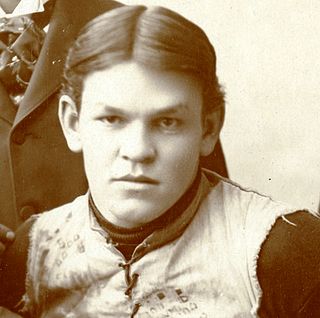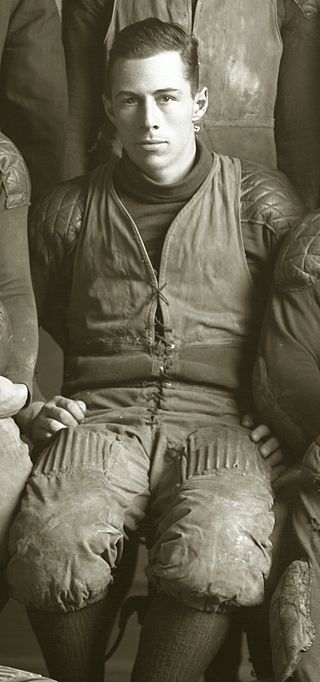Related Research Articles

Frederick William Schule was an American track and field athlete, football player, athletic coach, teacher, bacteriologist, and engineer. He competed for the track and field teams at the University of Wisconsin from 1900 to 1901 and at the University of Michigan in 1904. He was also a member of the undefeated 1903 Michigan Wolverines football team that outscored its opponents 565 to 6.

William Douglas Ward was an American college football player and coach, physician and surgeon. He played football at Princeton University from 1893 to 1894 and was the coach of the University of Michigan football team in 1896. He later became a physician and surgeon in Rochester, New York. He was a pioneer in early surgical procedures to construct artificial vaginas and published an article on the subject in 1915.
John William Knibbs Jr. was an American football player and coach.

James Carnahan Knight was an American football player and coach. He played college football at Princeton University in 1895 and at the University of Michigan in 1901. He was the head football coach at the University of Washington from 1902 to 1904 and compiled a 15–4–1 record.

James Baird was an American civil engineer, football player and coach. He played football for the University of Michigan from 1892 to 1895 and was captain of the 1894 team. He was also an assistant football coach at Michigan from 1897 to 1898. He worked for the George A. Fuller Co. for 23 years and eventually became its president. He later formed his own construction company called the James Baird Company. Baird directed the construction of many important buildings, including the Flatiron Building, Lincoln Memorial, Arlington Memorial Amphitheater, and Tomb of the Unknown Soldier.

George Edward Denman was an American teacher and football, basketball, and baseball coach. He served as the third head football coach at Michigan Agricultural College, now known as Michigan State University, from 1901 to 1902, compiling a record of 7–9–1. Bemies was also the second head basketball coach at Michigan Agricultural from 1901 to 1903, tallying a mark of 11–0, and the head coach of Michigan Agricultural's baseball team from 1902 to 1903, where his record was 9–15–1.
John David Wombacher was an American football player.
Lorain Francis Enoch Chamberlain Thorne was an American college football coach.
Dwight Grant Watson was an American college football player and coach. He was the head football coach at Michigan State Normal College during the 1899 college football season. He was also involved in the telephone industry in its early years, serving as manager of the Michigan Telephone Company in Kalamazoo, Michigan, and as the general manager of the Van Buren County Telephone Company in the years prior to his death.
Joseph Howard McCulloch was an American football, baseball, and basketball coach, teacher and athletic director. He played college football and baseball at Springfield College from 1908 to 1910. He was the athletic director and coach of the baseball and basketball teams at Carnegie Institute of Technology—now known as Carnegie Mellon University—from 1911 to 1918. After service in the military during World War I, he spent more than 30 years from 1919 through the mid-1950s as the athletic director at Michigan State Normal College—now known as Eastern Michigan University—and served stints as the head coach of the football, basketball and tennis teams.

Frederick Lee "Fritz" Rehor was an American football player. He played college football for Fielding H. Yost's Michigan Wolverines football teams from 1914 to 1916. He also played professional football and was a member of the 1917 professional football champion Massillon Tigers, coached by Knute Rockne. He later operated a drug store in Canton, Ohio.

Melvin J. "Tubby" Meyers, sometimes spelled "Myers," was an American college football player and coach. He was the first head coach and first captain of the Western State Normal football program, holding both titles as a player-coach during the 1906 college football season.

Harry Stevens Hammond was an American football player and businessman. He played college football at the University of Michigan from 1904 to 1907. He later had a career in business with the Pressed Steel Car Company and the National Tube Co.

Alfred Ellet Hitchner was an American football player, coach, electrical engineer and businessman. He was the head coach of the Rutgers Scarlet Knights football team in 1904. He later worked for many years for Westinghouse Electric Company in Pennsylvania and California.

Arthur Pierce Robinson was an American football coach and businessman. He was the head coach of the Rutgers Scarlet Knights football team during the 1901 college football season. He later worked for more than 24 years for the Ransome Concrete Machinery Company of Dunellen, New Jersey.
Walter Lisle "Ty" Krentler, sometimes shown as Walter Lyle Krentler, was an American football player. He played at the fullback position for the 1920 Detroit Heralds during the first regular season of the NFL. He also played college football for the University of Detroit in 1918 and 1919 and professional football for the Detroit Maroons in 1921.

Eugene Gentry "Guy" Neely was an American football player. Despite having only one arm, he played college football at the guard position for Dartmouth College and was a consensus first-team selection to the 1917 College Football All-America Team.

Leonard Franklin Hilty was an American football player. He played college football for the University of Pittsburgh and was a consensus selection at the tackle position on the 1918 College Football All-America Team.
Ralph Milton Wenzel was an American football player and officer in the United States Marine Corps. He was a first-team All-American at Tulane University in 1939, playing at the end position. He later played for the Pittsburgh Steelers in the National Football League (NFL) during the 1942 season while awaiting assignment to active duty in the Marine Corps.
James Willard Raynsford was an American football player. He played for the University of Michigan from 1912 to 1914 and was captain of the 1914 Michigan team.
References
- 1 2 3 Herman P. Miller (1918). Smull's Legislative Hand Book and Manual of the State of Pennsylvania 1918. J. L. L. Kuhn. p. 278f.
- ↑ "2012 NCAA Football Records: Consensus All-America Selections" (PDF). National Collegiate Athletic Association (NCAA). 2012. p. 4. Retrieved August 15, 2014.
- ↑ "Football" (PDF). The Outing Magazine. January 1900.
- 1 2 "Harwood E. Ryan and Lew Russell Palmer To Join Equitable". Insurance Newsweek. November 29, 1918. p. 10.
- ↑ 1920 U.S. Census entry for Lew R. Palmer, age 43, born in Michigan. Census Place: Yonkers Ward 8, Westchester, New York; Roll: T625_1281; Page: 5A; Enumeration District: 259; Image: 140. Ancestry.com. 1920 United States Federal Census [database on-line].
- ↑ 1930 U.S. Census entry for Lew Palmer, age 55, born in Michigan. Census Place: Yonkers, Westchester, New York; Roll: 1668; Page: 9A; Enumeration District: 0055; Image: 611.0; FHL microfilm: 2341402. Ancestry.com. 1930 United States Federal Census [database on-line].
- ↑ 1940 U.S. Census entry for Lew R. Palmer, age 65, born in Michigan. Census Place: Yonkers, Westchester, New York; Roll: T627_2865; Page: 10B; Enumeration District: 68-83. Ancestry.com. 1940 United States Federal Census [database on-line].
- ↑ "Lew Russell Palmer". Ohio Gravestones.org. Retrieved August 14, 2014.